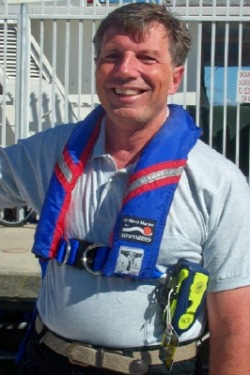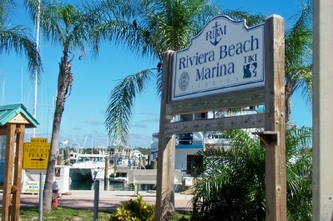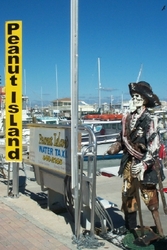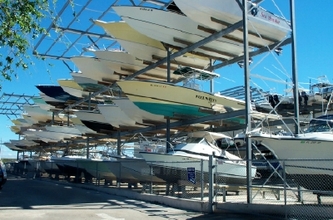
Riviera Beach Marina
We're starting to take root here in our slip at Riviera Beach Municipal Marina. The weather, while very pleasant, hasn't cooperated with the southerly winds needed to cross to the Bahamas. Two weeks after missing our original planned crossing to the Bahamas, we continue to see mostly cold fronts and their associated north winds and high waves. Since this is our first time crossing the Gulf Stream, we're perfectly happy to play it safe and wait for the more ideal conditions to cross.
Go ahead. Call us wimps. We don't care.
In the meantime, we've managed to take care of a few boat items that have needed attention.
Red Eye
With varying degrees of intensity, Cathy has been struggling with an eye irritation for months, whose cause was hard to determine. We speculated that it might be related to the drying effects of the wind and cold while underway, which made us wonder if we needed to do something to install a canvas windshield on the boat. However, it became clear that it was much more specific to the boat itself, when the condition cleared up over the 2 weeks away at Christmas and then started up again shortly after her return in January, even though we hadn't left the dock. Her doctor also had related it more to allergies, which caused us to look for possible causes on the boat.
We suspected mold or mildew, although Orion had no mildew smell. During the months of cold weather traveling down the ICW, the interaction between the warm air in the boat and cold air outside caused a lot of condensation that gradually became a breeding ground for mildew. Because there was no dramatic mildew smell (and because cleaning is not Cathy's number one favorite activity), we didn't recognize (or maybe ignored) the signs of the growing mold and mildew problem. We now knew this was something we had to address. We decided to start with a good cleaning of the aft cabin, where we sleep. We washed every surface in the cabin, including the undersides of all the panels and inside every compartment, with a bleach solution. This seemed to help some, but it wasn't completely solving the problem. Cathy began working her way with the same cleaning approach through the rest of the boat, but the redness and irritation was becoming chronic and painful. It was being amplified by the many hours spent inside the boat at the marina, closed up tight to hold in the air conditioning.
Without some solution, our cruising days were going to have to end sooner rather than later.
About this time, we saw an ad for a mold treatment service, Certified Mold Treatment, which claimed to address mold and mildew on boats, as well as houses, offices, etc. Dave did some research on the internet and talked to our neighbors in the marina, discovering that this was an ozone treatment, and that it seemed to be very effective. We talked to Brad from the local office, and arranged an appointment to have him treat our boat the next day. In preparation, we still cleaned the rest of the boat with the bleach solution, opened up every cabinet, and turned up all of the cushions. It took only about 2 hours for the treatment, which Brad pumped in from a portable unit on the dock. We then waited a half hour for the ozone to dissipate (it turns back into oxygen), and waited to see what effect it would have.
Cathy noticed an immediate improvement. The burning in her eyes subsided dramatically.
Until she went to bed.
In less than an hour, her eyes started burning again, indicating the ozone had not penetrated into the depths of the foam pillow. Although we had washed the pillow with bleach earlier that week, that and the ozone treatment had failed to penetrate the foam in the pillow sufficiently. She tossed the pillow on the floor and the burning subsided. The next day, we promptly replaced all of the pillows, which had the desired effect. We will likely be replacing our pillows with some regularity from now on.
Cathy's still not symptom-free, but each day seems to improve the situation. It took several days over Christmas for her eyes to return to normal, so the hope is that this will be the case in the next few days.
Riviera Beach
Whenever anyone asks where we’re waiting for our weather window to go to the Bahamas, we tell them we’re in “Palm Beach”, since it is the most recognizable city near our current location. It also conjures images of luxury condominiums, resort amenities, palm trees, ocean breezes, etc. This helps continue the myth that cruising is all about luxury and relaxation. We have visited West Palm Beach, which has a beautiful city center, called "City Place", with pleasant stores, walkways, outdoor cafes and a free trolley that circles the area.
However, our precise location is in the town of Riviera Beach, docked at their municipal marina. Although only a few miles from the high class West Palm Beach downtown, Riviera Beach is worlds away in other ways. While the marina is a welcoming community of mostly live-aboard boaters (and very affordable), the streets just outside the marina are among the most economically depressed in the area. We don't hesitate to walk these streets during the day to do shopping nearby, but we've always heeded the warnings of our neighbors to "be inside the gate before dark". (The marina has locked gates on every pier. You even have to use the key to get out.)
The marina itself seems to be the gathering place for the community to have access to the water. There is a launch facility for the many boats in the "hotel" stacked storage, a pleasant open air restaurant by the water, several charter companies for dive trips, jet skis, fishing charters, etc. There is live music every day at the restaurant, which makes for pleasant afternoons and evenings.
Go ahead. Call us wimps. We don't care.
In the meantime, we've managed to take care of a few boat items that have needed attention.
Red Eye
With varying degrees of intensity, Cathy has been struggling with an eye irritation for months, whose cause was hard to determine. We speculated that it might be related to the drying effects of the wind and cold while underway, which made us wonder if we needed to do something to install a canvas windshield on the boat. However, it became clear that it was much more specific to the boat itself, when the condition cleared up over the 2 weeks away at Christmas and then started up again shortly after her return in January, even though we hadn't left the dock. Her doctor also had related it more to allergies, which caused us to look for possible causes on the boat.
We suspected mold or mildew, although Orion had no mildew smell. During the months of cold weather traveling down the ICW, the interaction between the warm air in the boat and cold air outside caused a lot of condensation that gradually became a breeding ground for mildew. Because there was no dramatic mildew smell (and because cleaning is not Cathy's number one favorite activity), we didn't recognize (or maybe ignored) the signs of the growing mold and mildew problem. We now knew this was something we had to address. We decided to start with a good cleaning of the aft cabin, where we sleep. We washed every surface in the cabin, including the undersides of all the panels and inside every compartment, with a bleach solution. This seemed to help some, but it wasn't completely solving the problem. Cathy began working her way with the same cleaning approach through the rest of the boat, but the redness and irritation was becoming chronic and painful. It was being amplified by the many hours spent inside the boat at the marina, closed up tight to hold in the air conditioning.
Without some solution, our cruising days were going to have to end sooner rather than later.
About this time, we saw an ad for a mold treatment service, Certified Mold Treatment, which claimed to address mold and mildew on boats, as well as houses, offices, etc. Dave did some research on the internet and talked to our neighbors in the marina, discovering that this was an ozone treatment, and that it seemed to be very effective. We talked to Brad from the local office, and arranged an appointment to have him treat our boat the next day. In preparation, we still cleaned the rest of the boat with the bleach solution, opened up every cabinet, and turned up all of the cushions. It took only about 2 hours for the treatment, which Brad pumped in from a portable unit on the dock. We then waited a half hour for the ozone to dissipate (it turns back into oxygen), and waited to see what effect it would have.
Cathy noticed an immediate improvement. The burning in her eyes subsided dramatically.
Until she went to bed.
In less than an hour, her eyes started burning again, indicating the ozone had not penetrated into the depths of the foam pillow. Although we had washed the pillow with bleach earlier that week, that and the ozone treatment had failed to penetrate the foam in the pillow sufficiently. She tossed the pillow on the floor and the burning subsided. The next day, we promptly replaced all of the pillows, which had the desired effect. We will likely be replacing our pillows with some regularity from now on.
Cathy's still not symptom-free, but each day seems to improve the situation. It took several days over Christmas for her eyes to return to normal, so the hope is that this will be the case in the next few days.
Riviera Beach
Whenever anyone asks where we’re waiting for our weather window to go to the Bahamas, we tell them we’re in “Palm Beach”, since it is the most recognizable city near our current location. It also conjures images of luxury condominiums, resort amenities, palm trees, ocean breezes, etc. This helps continue the myth that cruising is all about luxury and relaxation. We have visited West Palm Beach, which has a beautiful city center, called "City Place", with pleasant stores, walkways, outdoor cafes and a free trolley that circles the area.
However, our precise location is in the town of Riviera Beach, docked at their municipal marina. Although only a few miles from the high class West Palm Beach downtown, Riviera Beach is worlds away in other ways. While the marina is a welcoming community of mostly live-aboard boaters (and very affordable), the streets just outside the marina are among the most economically depressed in the area. We don't hesitate to walk these streets during the day to do shopping nearby, but we've always heeded the warnings of our neighbors to "be inside the gate before dark". (The marina has locked gates on every pier. You even have to use the key to get out.)
The marina itself seems to be the gathering place for the community to have access to the water. There is a launch facility for the many boats in the "hotel" stacked storage, a pleasant open air restaurant by the water, several charter companies for dive trips, jet skis, fishing charters, etc. There is live music every day at the restaurant, which makes for pleasant afternoons and evenings.
Our neighbors are very friendly and helpful. We've been offered free ice from our neighbor's ice machine, instruction in tying a Turk's Head knot (for the steering wheel centerline), recommendations on restaurants and shopping and more. The residents look out for each other, since most have been neighbors for years and helped each other weather the hurricanes of 2004. They readily included us in their circle as well.

Safety
Since we had entered the new year, it was time to get a new safety inspection sticker. We got one of these just before leaving Solomons in June of last year. It was a good way to verify our preparations, as well as minimizing the chance that we might be boarded by the Coast Guard. We were visited by another member of the Power Squadron, this time from the Palm Beach area, who checked out Orion's safety gear and certified her for 2007.
Since we had entered the new year, it was time to get a new safety inspection sticker. We got one of these just before leaving Solomons in June of last year. It was a good way to verify our preparations, as well as minimizing the chance that we might be boarded by the Coast Guard. We were visited by another member of the Power Squadron, this time from the Palm Beach area, who checked out Orion's safety gear and certified her for 2007.

Dave also spent some more time on eBay shopping for an EPIRB. (Emergency Position Indicating Radio Beacon) The cost of the smaller Personal Locator Beacons was coming down to the point that it made sense to get one. He decided to purchase the ACR PLB-200 model, which allows input of GPS coordinates and will send a signal on 406Mhz as well as 121 Mhz. The GPS coordinates give your exact location within minutes. The continuous radio signal on 406 Mhz is used to triangulate a position from hundreds of miles away. The 121Mhz signal is used when vessels are nearby to zero in on your exact position. The unit has to be registered with NOAA along with information about the boat and emergency contacts, which we did. It is small enough to be mounted on a PFD as well. So, whomever is most likely to go over will get to wear it. It looks good on Dave, don't you think?
We hope we never have to use it.
We hope we never have to use it.

So, what about the Bahamas?
We haven't forgotten about the Bahamas. We've studied the guidebooks and blogs of friends who are ahead of us to map out a possible trip through the Abacos. We will probably work our way around from West End to Marsh Harbor on the east side of Great Abaco. We're thinking we will spend up to 2 months in the Abacos, heading back in mid- to late March.
The delay in our departure allowed our mail, including our customs sticker to catch up with us, so it is now mounted in the cockpit. This allows us to clear US customs when we return with just a phone call. However, we would still need to "present ourselves" in person to Immigration upon our return within 24 hours. We discovered that there is a way to handle this with a phone call as well, using a new "Local Boater Option" program that is being piloted in Florida. We apply for a Boater Registration number, which we provide via a phone call on our return to the US. The process normally requires that we make an appointment with Customs to complete the application. However, we took a walk over to the Customs office early on Monday morning and they processed our application on the spot. So we now have our Boater registration number. Cool!
Unfortunately, time spent in the marina means access to stores and shopping, so we keep finding things we "need", which is becoming increasingly difficult to stow in our stuffed boat. It will be a good thing (for our budget) to get off the dock and underway again.
We haven't forgotten about the Bahamas. We've studied the guidebooks and blogs of friends who are ahead of us to map out a possible trip through the Abacos. We will probably work our way around from West End to Marsh Harbor on the east side of Great Abaco. We're thinking we will spend up to 2 months in the Abacos, heading back in mid- to late March.
The delay in our departure allowed our mail, including our customs sticker to catch up with us, so it is now mounted in the cockpit. This allows us to clear US customs when we return with just a phone call. However, we would still need to "present ourselves" in person to Immigration upon our return within 24 hours. We discovered that there is a way to handle this with a phone call as well, using a new "Local Boater Option" program that is being piloted in Florida. We apply for a Boater Registration number, which we provide via a phone call on our return to the US. The process normally requires that we make an appointment with Customs to complete the application. However, we took a walk over to the Customs office early on Monday morning and they processed our application on the spot. So we now have our Boater registration number. Cool!
Unfortunately, time spent in the marina means access to stores and shopping, so we keep finding things we "need", which is becoming increasingly difficult to stow in our stuffed boat. It will be a good thing (for our budget) to get off the dock and underway again.



